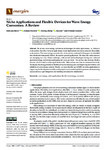Niche Applications and Flexible Devices for Wave Energy Conversion: A Review
| dc.contributor.author | Renzi, E | |
| dc.contributor.author | Michele, Simone | |
| dc.contributor.author | Zheng, Siming | |
| dc.contributor.author | Jin, S | |
| dc.contributor.author | Greaves, Deborah | |
| dc.date.accessioned | 2021-10-20T19:50:07Z | |
| dc.date.available | 2021-10-20T19:50:07Z | |
| dc.date.issued | 2021-10-12 | |
| dc.identifier.issn | 1996-1073 | |
| dc.identifier.issn | 1996-1073 | |
| dc.identifier.other | ARTN 6537 | |
| dc.identifier.uri | http://hdl.handle.net/10026.1/18131 | |
| dc.description.abstract |
<jats:p>We review wave energy conversion technologies for niche applications, i.e., kilowatt-scale systems that allow for more agile design, faster deployment and easier operation than utility scale systems. The wave energy converters for niche markets analysed in this paper are classified into breakwater-integrated, hybrid, devices for special applications. We show that niche markets are emerging as a very vibrant landscape, with several such technologies having now achieved operational stage, and others undergoing full-scale sea trials. This review also includes flexible devices, which started as niche applications in the 1980s and are now close to commercial maturity. We discuss the strong potential of flexible devices in reducing costs and improving survivability and reliability of wave energy systems. Finally, we show that the use of WECs in niche applications is supporting the development of utility-scale projects by accumulating field experience, demonstrating success stories of grid integration and building confidence for stakeholders.</jats:p> | |
| dc.format.extent | 6537-6537 | |
| dc.language | en | |
| dc.language.iso | en | |
| dc.publisher | MDPI | |
| dc.subject | wave energy | |
| dc.subject | niche applications | |
| dc.subject | flexible wave energy converters | |
| dc.title | Niche Applications and Flexible Devices for Wave Energy Conversion: A Review | |
| dc.type | journal-article | |
| dc.type | Review | |
| dc.type | Journal | |
| plymouth.author-url | https://www.webofscience.com/api/gateway?GWVersion=2&SrcApp=PARTNER_APP&SrcAuth=LinksAMR&KeyUT=WOS:000714793300001&DestLinkType=FullRecord&DestApp=ALL_WOS&UsrCustomerID=11bb513d99f797142bcfeffcc58ea008 | |
| plymouth.issue | 20 | |
| plymouth.volume | 14 | |
| plymouth.publication-status | Published online | |
| plymouth.journal | Energies | |
| dc.identifier.doi | 10.3390/en14206537 | |
| plymouth.organisational-group | /Plymouth | |
| plymouth.organisational-group | /Plymouth/Faculty of Science and Engineering | |
| plymouth.organisational-group | /Plymouth/Faculty of Science and Engineering/School of Engineering, Computing and Mathematics | |
| plymouth.organisational-group | /Plymouth/PRIMaRE Publications | |
| plymouth.organisational-group | /Plymouth/REF 2021 Researchers by UoA | |
| plymouth.organisational-group | /Plymouth/REF 2021 Researchers by UoA/UoA12 Engineering | |
| plymouth.organisational-group | /Plymouth/Research Groups | |
| plymouth.organisational-group | /Plymouth/Research Groups/Marine Institute | |
| plymouth.organisational-group | /Plymouth/Users by role | |
| plymouth.organisational-group | /Plymouth/Users by role/Academics | |
| plymouth.organisational-group | /Plymouth/Users by role/Researchers in ResearchFish submission | |
| dcterms.dateAccepted | 2021-10-03 | |
| dc.rights.embargodate | 2021-10-22 | |
| dc.identifier.eissn | 1996-1073 | |
| dc.rights.embargoperiod | Not known | |
| rioxxterms.versionofrecord | 10.3390/en14206537 | |
| rioxxterms.licenseref.uri | http://www.rioxx.net/licenses/all-rights-reserved | |
| rioxxterms.licenseref.startdate | 2021-10-12 | |
| rioxxterms.type | Journal Article/Review |


